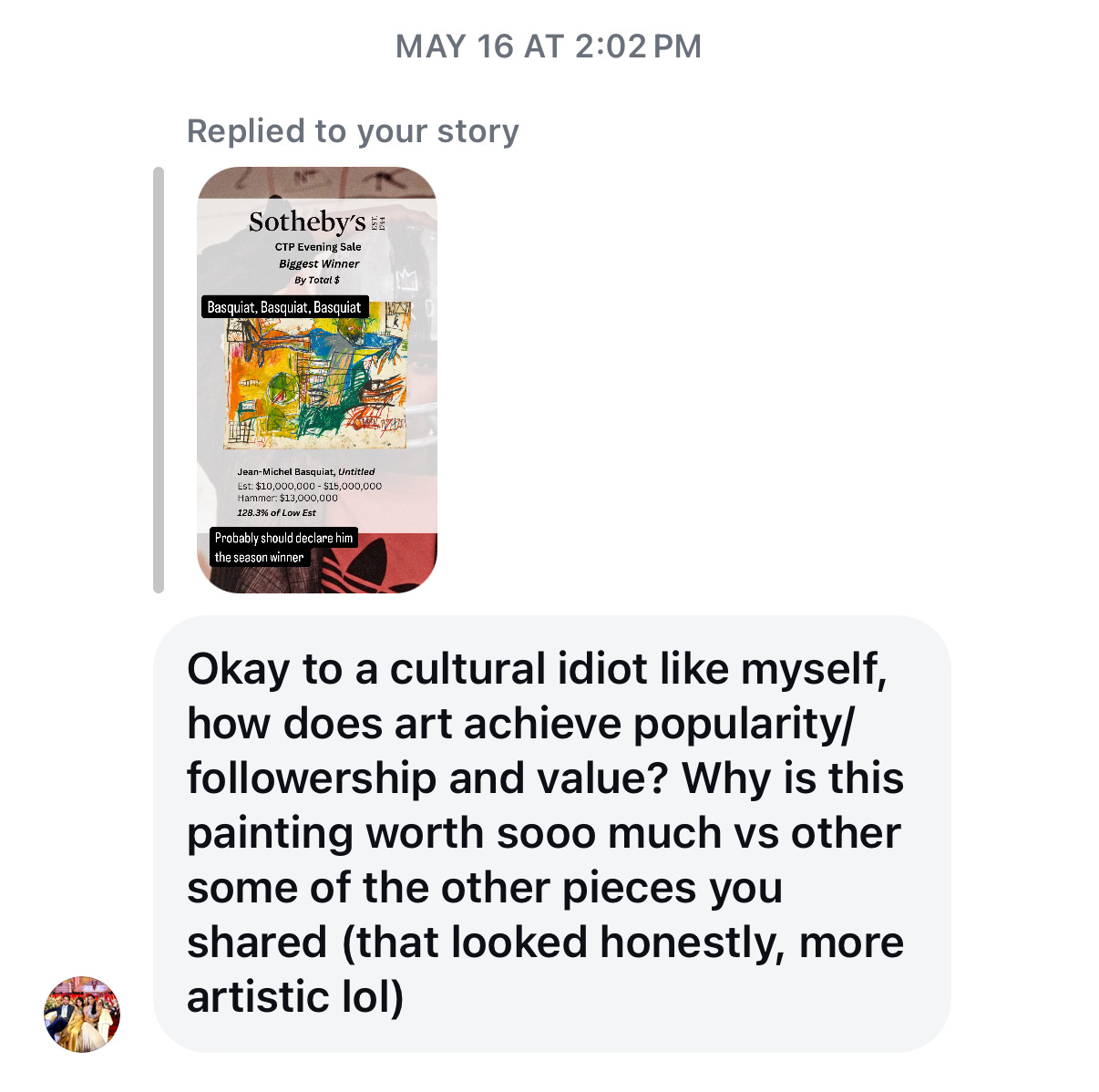How to Price the Priceless: Art Market 101
Welcome to the Gnosienne Value Model. Step one: the quantifiable stuff. Step two: chaos.
Good afternoon, friends. Sunshine! Finally! Blessed be the summer sun that breaks through the clouds. It’s remarkable how much energy I gain simply from the weather being better.
ANYWAYS, you don’t want to read a weather report, you want to read about art!
Following my last newsletter (Auction Dispatch: May Sales edition), I received several DMs from readers wanting to better understand what underpins the value of art. Why, for instance, is a Basquiat worth over $20 million, while a street artist in Soho sells a Basquiat-esque cow painting for just $20?

So, for this installment of Art Market 101…
What Makes Art Valuable?
When faced with an inimitable masterwork—a fragment of material culture miraculously surviving time's relentless erosion, painted by a genius long departed—it feels vulgar to assign it monetary value.
Yet the practical question remains: How much is this worth?
How does one price the priceless?
Monetary valuation of art matters not merely to facilitate sales or price into your apartment-decorating budget, but because for contemporary works, valuation directly sustains artists' livelihoods. The numbers we attach to cultural production reflect and shape what society prioritizes, preserves, and ultimately values.
Whether you’re curious about art valuation as a budding collector or enjoy auction results like the Super Bowl (which I’m told is a sports event of some kind), this series will illuminate what gives art its value.
This article dives into Objective Factors: size, medium, age, condition, and rarity – these set-up the conversation around things that cannot be altered or changed, oftentimes laying the foundations for comparisons we make between two completely unique pieces.
Free subscribers (hopefully that’s you) will see more articles soon diving into other factors including the mysterious *error term* oooo ahhhh.
By series end, you'll be familiar with the “factor model” I use to understand art market performance and perhaps never see a gallery the same way again. Either way it will give you some fun conversation fodder for your next dinner party ;)
Nota Bene:
Remember, you need not agree with the final value any artwork achieves! An often-overlooked aspect of the art market, especially at its upper echelons, is the fluctuating value of capital. If a buyer’s wealth overfloweth the day of the auction, they might pay more than they would the very next day when the market dips.
This framework isn't an endorsement of prices, merely a way to systematically unpack value. The beauty is in assigning your own weights to each factor; perhaps historical significance resonates deeply because you relish living with history, or maybe dimensions matter most because you're filling space above a mantelpiece. The sum totals are intriguing, but the significance is ultimately subjective and personal.
Without further ado, let's get into Objective Factors.
Objective Factors
There are 5 central objective factors when it comes to art:
Size
Medium
Age
Condition
Rarity
These objective factors are the physical reality of the works. They are more unbiased than things like “Artist Momentum” which we will get to in an article coming soon. They’re like math vs. creative writing. Hard to argue about 2 + 2.
Let’s define each of these factors a bit more robustly:
Size: Yes, you guessed it, size matters. Generally speaking, larger artworks command higher prices due to their increased material cost, the artist’s invested time, and the inherent grandeur they convey.
Caveat: But the relationship isn't linear. There’s a sweet spot. Extremely large pieces risk hitting a practical ceiling, constrained by the realities of display and storage, thus limiting their pool of potential buyers to those with cathedral-sized living rooms.

Medium: The materials used in the work. Oil-on-canvas works traditionally fetch higher prices than works on paper due to their durability, established historical cachet, and traditional appeal. But this rule isn't absolute and context is king.
I’d pay more for a beautiful drawing than an ugly oil painting.Age: Age in art valuation is multifaceted. It means the literal age of the piece, when it was created within the artist’s career, its connection to significant art movements and specific dates (i.e., is this the first Balloon Dog created by Jeff Koons? Or the 900th edition?). Works that mark critical turning points or stylistic breakthroughs usually demand premium prices.
Caveat: Here’s the rub. Market trends fluctuate (we will talk about this in upcoming weeks), and can elevate different periods within an artist’s career. Picasso’s later works from the 1960s and 70s, for instance, have surged recently, even though his highest records remain dominated by earlier Blue, Rose, and Cubist periods.
Condition – Break out the blacklight. From a botched 19th century restoration on a 17th century canvas to mold on the mat for a paper work, damaged or deteriorated works can see their market values tumble. Vigilant conservation isn't just housekeeping—it's asset management (see what I did there, it's a joke because I work for an asset manager).
Rarity: Perhaps the art market's most powerful catalyst. Collectors eagerly pay premiums for unique pieces or limited editions, drawn by the exclusivity and prestige these artworks promise. Especially when you get into the higher brackets, then you get to say obnoxious things like “well *my* Monet is the only one in private hands from this series. But yours has lovely light.”
Caveat: Rarity can be a double-edged sword. Collectors need to understand a work’s relative value to other works (i.e., you need a benchmark) to know what they’re paying for. Sometimes, you get burned for being too different. Sometimes it pays off. Always a weird one.
Now that we have a working knowledge of these 5 factors, let’s deconstruct the sale result that started us down this road: Basquiat’s "Untitled" (1981) that sold at Sotheby’s this May.
Example: Jean-Michel Basquiat,
Untitled (1981)
NB: Without the Buyer’s Premium, this work sold at ~$13mm.*
Size: At 127.6 x 160 cm, "Untitled" this piece is monumental for paper-based work, positively impacting its value and reinforcing the significance of scale, even for traditionally less-valued mediums.
Medium: Paper typically trades lower than canvas in valuation, so the piece undoubtedly relies on other factors to boost its worth.
Age: Created in 1981, this artwork captures a critical stylistic evolution—Basquiat's leap from street artist to studio powerhouse—significantly boosting its historical cachet and thus its market clout. If you’re after Basquiat, you’re after something from the early 1980s.
Rarity: While multiple Basquiats hit the market recently, none matched this large-scale paper piece. What this translates to in market psychology is a dynamic where bidders would be interested in Basquiat canvas (paintings on canvas of oil, generally a higher price point) perceive this as a ‘deal’ and bidders who would be interested in Basquiat normally, but it's priced above what they could pay would also be motivated to get this piece because of the size and noble period.
So, up up up goes the value.
So there you have it.
To understand how much any work of art is valued at, you have to start with these five basics. Once you understand these, you can start to ask the more complicated questions like – Who owned the work previously? Which gallery represents the artist? Is there a work like this in a museum collection?
Next week we will start to hit that second derivative stage, Historical Narrative Factors – the story an artwork tells through its past ownership, public appearances and scholarly context, and how this shapes its economic value.
Thanks for joining me on this journey, see you soon ;)
*The reported final price is actually under $13mm, which indicates to me that it was bought by the irrevocable bidder and they received a fee. However, the pricing analysis for this piece remains valid as the IB’er chased the work so they continued to bid. We will dive into the Guarantee/Irrevocable Bidder dynamics in a future newsletter, but you’ll have to prove to me you’re ready for some heavy mathematics.









I would be very interested in reading an article by you comparing artworks to other luxury markets aka fashion or boats. How and why relative value is created for each industry. A Chanel bag is not unique yet more appreciated in value
Thank you for starting with the basics, but also explaining how every rule can be challenged in extenuating circumstances! so helpful!